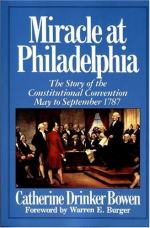
|
| Name: _________________________ | Period: ___________________ |
This test consists of 15 multiple choice questions and 5 short answer questions.
Multiple Choice Questions
1. Why is Amos Singletry opposed to the Constitution?
(a) He believes it favors the lawyers and the elite at the expense of the less-educated and less-well-to-do farmers.
(b) He believes that Massachusetts loses too much power under a national government.
(c) He believes it prevents Maine from separating from Massachusetts.
(d) He believes that it offers too much to the citizens of the Southern states.
2. What is the federal ratio?
(a) The distance needed between the seat of federal government and any state or local government.
(b) The number of property owners needed to grant statehood to an area of the Western Territory.
(c) The number of Congressional delegates needed to override a Presidential veto.
(d) The ratio used to determine how many slaves are equivalent to one free white citizen.
3. What are the Federalist Papers?
(a) The published version of Washington's description of the Convention.
(b) The published version of Madison's notes from the Convention.
(c) A series of articles published in New York newspapers against the ratification of the Constitution.
(d) A series of articles published in New York newspapers supporting the ratification of the Constitution.
4. Which delegate voices a moral defense of slavery?
(a) Elbridge Gerry.
(b) Benjamin Franklin.
(c) Charles Pinckney.
(d) Edmund Randolph.
5. Which delegate is vehemently against the idea of a standing army?
(a) Ellsworth.
(b) James Madison.
(c) Elbridge Gerry.
(d) Governor Morris.
6. Who is named Chairman of the Committee of Style and Arrangement?
(a) James Madison.
(b) Alexander Hamilton.
(c) William Samuel Johnson.
(d) Rufus King.
7. Which delegate to the Pennsylvania Convention is most vocal in his support for the Constitution?
(a) James Wilson.
(b) Benjamin Franklin.
(c) George Bryan.
(d) Justice McKean.
8. Which delegate argues that the only requirement for a legislator is citizenship, with no restriction on the length of time the individual has been in America?
(a) Edmund Randolph.
(b) Pierce Butler.
(c) Alexander Hamilton.
(d) James Madison.
9. Why is it necessary for the Western Territories to have an ocean port?
(a) It enables them to trade effectively with others.
(b) It enables them to have a navy in case of war.
(c) It enables them to fish and expand their diet.
(d) It enables them to travel and explore the rest of the continent.
10. What is the result of the Great Compromise?
(a) Every state has two Senators.
(b) Every state is able to participate in the National legislature.
(c) Every state is able to choose their own representation.
(d) Every state is able to abolish slavery.
11. How does George Washington show his approval or disapproval of measures discussed at the Convention?
(a) By delivering long speeches.
(b) By sharing his comments with Madison, who presents them to the full Convention.
(c) By making short comments.
(d) By smiling or frowning.
12. By August 30th, what date has been set for the final adjournment?
(a) No date has been set.
(b) September 31st.
(c) September 1st.
(d) August 31st.
13. Which state has the largest delegation present at the end of the Convention?
(a) Massachusetts.
(b) Pennsylvania.
(c) Virginia.
(d) New York.
14. Which state has only one delegate sign the Constitution?
(a) Pennsylvania.
(b) Virginia.
(c) Massachusetts.
(d) New York.
15. Why are Philadelphia's artisans and mechanics in favor of the Constitution?
(a) They believe it gives them additional opportunities to enter government.
(b) They believe it improves trade with Europe.
(c) They believe it opens the Western Territories and give them a chance to own property.
(d) They believe it makes them equivalent to the wealthy landowners.
Short Answer Questions
1. Which delegate makes the motion that an address to the people accompanies the Constitution?
2. In Chapter 21, what does George Mason want to be included in the Constitution?
3. Which delegate signs the letter to Congress as a representative of all Convention delegates?
4. Why is Pierce Butler opposed to foreigners without a long residence in America being elected to Congress?
5. In the events presented in Chapter 18, what patriotic measure does George Mason introduce?
|
This section contains 717 words (approx. 3 pages at 300 words per page) |

|




